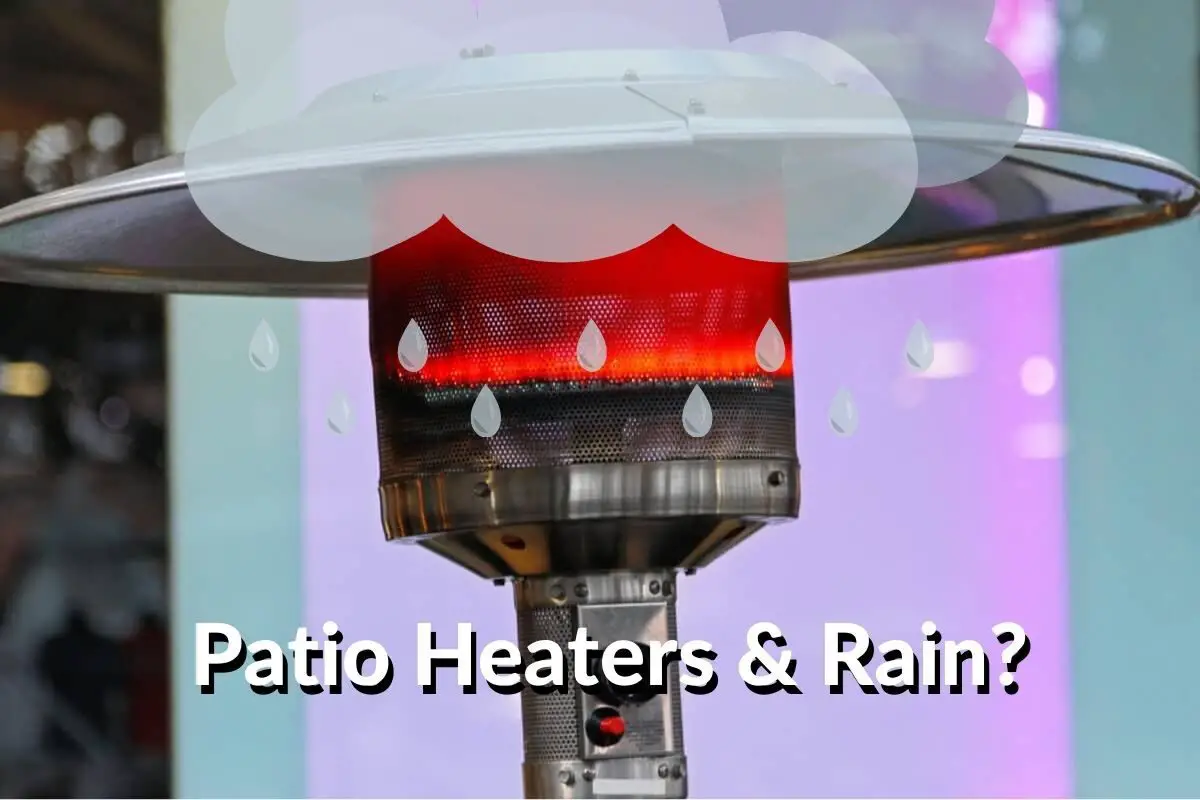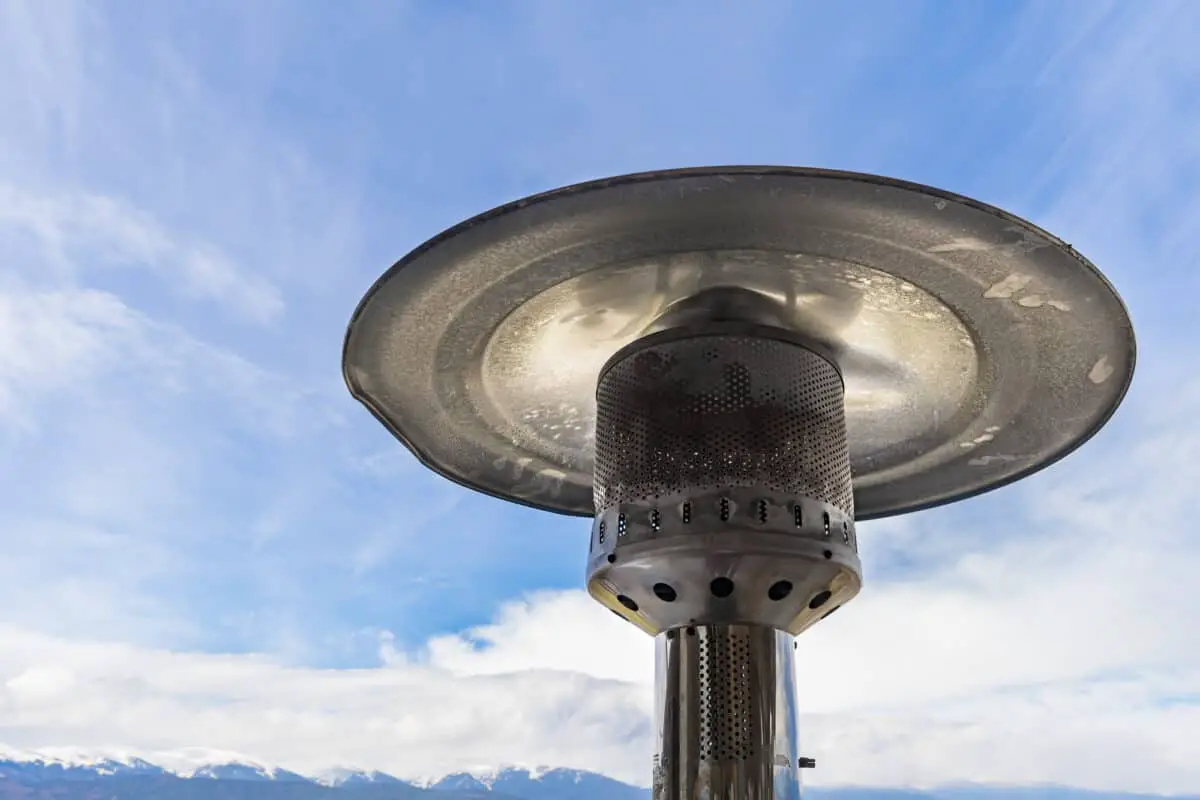Most gas-based outdoor heaters are safe to leave out in the rain. However, using an outdoor patio heater in the rain is still not recommended.
Recurring exposure to rain for patio heaters could lead to the faster deterioration of the heater’s parts, decreasing its lifespan.
While most outdoor heaters are built to withstand the occasional drizzle, frequently leaving an outdoor patio heater in the rain can speed up their long-term deterioration.
If you want to maximize your outdoor spaces during the cooler seasons, outdoor heaters are a great choice. Once you learn to use these devices, they can be practical alternatives to building a fire.
But compared to a fire, you may wonder if you could use an outdoor patio heater in the rain. Or perhaps you’re glancing outside right now, watching a rainstorm coming down on your brand-new outdoor patio heater.
Outdoor heaters, by their definition, are meant to be used outdoors. As such, their designers usually take rain and snow into consideration.
Can outdoor heaters be left out in the rain?
In this article, we will explore this subject in detail. We will examine the various outdoor heaters and tell you how they will fare in the rain.
Furthermore, we will explore some tips on better caring for your outdoor heater and extending its lifespan.

Table of Contents
Using An Outdoor Patio Heater in The Rain
Natural gas and propane patio heaters will continue to work in the rain.
However, frequently exposing an outdoor patio heater to the rain can cause early and avoidable wear and tear.
Electric heaters should never be left out directly in the rain, especially while energizing and operating.
We always recommend getting a cover for your outdoor heaters for an easy way to increase their lifespan.
You may notice some outdoor dining restaurants use electric heaters. It is unlikely they move heaters indoors before every rainfall.
These outdoor electric heaters are often protected from rainfall with a canopy to ensure the water does not directly hit the elements and electrical source.
You shouldn’t see these electric heaters in operation whenever rain can soak the heater.
Let’s look at the three main types of outdoor heaters and how they fare when exposed to rain.
Fixed Gas-Based Outdoor Heaters
Fixed gas-based patio heaters, by definition, are fixed to a specific position where they are directly linked up to the natural gas lines.
The fixed heater makes it impossible to move around like the other heaters.
Fortunately, most manufacturers consider this factor when designing these outdoor heaters.
As their name suggests, these heaters are designed for outdoor use, so there’s no point installing them indoors.
The outdoors is prone to rain or snow now and then; therefore, most heaters are designed to withstand the elements.
Although designed for outdoor use, having a cover handy would still be a good idea. The cover will help protect the outdoor patio heater in the rain.
This will also increase the overall lifespan of the heater.
Remember to make sure the heater has cooled down before you cover it.

Portable Outdoor Heaters
Like their fixed counterpart, portable outdoor heaters that use gas such as propane are usually designed to withstand rain.
But unlike fixed outdoor heaters, these can be moved around.
Moving a portable outdoor heater when it rains would be a good idea.
This shouldn’t be too much of an inconvenience.
Having an outdoor patio heater in the rain wouldn’t be used anyway. Chances are, no one will sit around the heater in the rain.
Moving to someplace where the rain can’t get to it will help protect the heater from deterioration over the long term.
Remember that these heaters can be heavy, particular models like a pyramid gas patio heater.
It could be difficult to move them at the last moment.
Letting the heater cool off beforehand would be best, and moving it just before it drizzles.
Electric Infrared Heaters
As you might have already guessed, electric infrared outdoor heaters should not be left out when it is raining.
Electricity and water, as a general rule, can be hazardous.
Most electric heaters aren’t as heavy as gas-based heaters, so moving them around shouldn’t be too tricky.
Some restaurants with outdoor dining have a rooftop patio structure with heaters mounted underneath.
This is a different scenario compared with portable infrared heaters.
Getting a Rain Cover for Your Outdoor Heater
Getting a cover for your outdoor patio heater in the rain could help you extend its lifespan.
Most outdoor heaters are very heavy, and it isn’t always practical to move them around all the time.
Additionally, we may not always be available to move an outdoor patio heater in the rain.
And while some patio heater models can withstand the rain, it could deteriorate their parts and decrease their lifespan.
This is where a cover can be just what you need to protect the outdoor patio heater in the rain.
Ideally, you want to purchase a patio heater cover with a high-temperature rating.
You should generally let the heater cool down before you cover it, but you may need to move quickly, depending on the scenario.
The cover could be required to withstand some residual heat left by the heater.
Related Reading: Are Patio Heaters Waterproof? | Avoid a Damaged Unit
Can You Put a Patio Heater Under a Covered Patio or Porch?
One alternative you could consider is using outdoor heaters under a covered patio.
Contrary to popular belief, outdoor heaters are safe under a covered patio if the proper precautions have been taken.
For most mushroom-style patio heaters, a clearance of two feet from the top of the heater to the roof should suffice.
Given the large size of these heaters, you would need your patio cover at least 10 feet from the ground.
Also, all outdoor heaters should be kept at a sufficient distance (around 6 feet) from combustible materials such as umbrellas, wood, etc.
Outdoor heaters produce radiant heat that simply heat the objects in their vicinity. This means that, unlike air heaters, they don’t blow warm air around the space.
A heater may be slightly more efficient out in the open.
How much of a difference does keeping a heater out in the open make? Not a lot! The patio cover, however, does aid in improving the long-term durability of the heater.
Using the heater under a covered patio could be an excellent alternative to having an outdoor patio heater in the rain.
Frequently Asked Questions
Can outdoor patio heaters be used in winter?
Electric and fixed natural gas-based heaters should work just fine under low temperatures.
However, propane-based portable heaters may slightly reduce performance at 40°F (approximately 4 °C).
This is because the composition of propane tends to change at lower temperatures.
While the heater will continue to produce heat, it will be less than that produced over 4°C.
For these reasons, if you expect the temperature around you to routinely go below 4°C, consider getting a natural gas-based fixed heater or an electric heater.
Will outdoor heaters work when it’s windy?
Most outdoor infrared heaters will start to see a decline in performance when the wind speed exceeds 10 miles per hour.
Furthermore, with stronger winds, you could risk tipping the heater over, potentially starting a fire.
Using an outdoor heater is not recommended when strong winds blow.
It will require you to clean your patio heater more often and could cause difficulty with lighting it next time.
What type of outdoor heater do you recommend?
With context to this article, a portable gas-based heater would be your best bet if you are anticipating rain.
Not only can it be covered like a fixed outdoor heater, but it can also be moved around when necessary.
A natural gas-based fixed heater would fare better under lower temperatures.
So, if you also expect lower temperatures, choose the natural gas-based fixed heater, but ensure you have enough space if it will be undercover.
Electric heaters should not be left out in the rain since they are not waterproof electrical appliances.
Of course, electric heaters have their advantages, but when it comes to rain, you shouldn’t risk electrocution.
Continue Reading: Pyramid Heater vs. Patio Heater [PROS & CONS]
Conclusion
Can you use patio heaters in the rain? Yes, but under certain circumstances, with the proper infrastructure.
You can use a particular type of outdoor patio heater in the rain, but remember, protecting it will prolong its lifespan.
Extra caution should be used with outdoor electric heaters to ensure they are adequately protected from the rain or not electrically energized.
Having a high-temperature tarp cover could be helpful in these scenarios.
Fixed heaters can’t be moved, and most portable ones are too heavy to move whenever it rains.
A cover can be a practical way to protect an outdoor patio heater in the rain.
Enjoy living the outdoor life!!!
